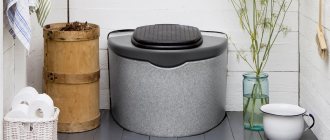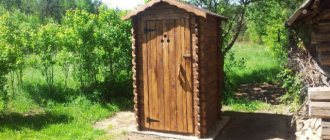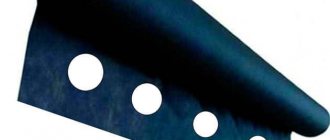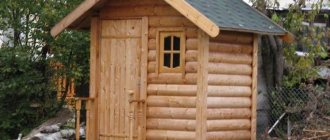One of the pressing problems faced by owners of a plot of land for a house or cottage is the construction of a latrine. In the absence of a central sewer system, there is nothing left to do but solve the problem yourself.
The easiest way out is to dig a cesspool under a small wooden cabin. A significant disadvantage of this plan is the unpleasant odor that inevitably arises after some time of use. Therefore, more and more often, summer residents and country residents are choosing dry toilets.
Choosing a dry closet by type
Based on the method of “processing” waste, there are three types of bio toilets for dachas.
Peat dry toilets
These are direct descendants of powder closets, in which the faeces were covered with peat before being transferred to a holding tank. The organic matter of peat was “responsible” for the primary processing and separation of waste into liquid and “solid” phases. Modern samples, unlike their predecessors, are charged with a mixture enriched with active bacteria, so separation occurs much faster and more efficiently.
The solid phase is disposed of in a compost pit, and after a couple of years they have “pure” organic fertilizer for the site. The liquid phase has a sufficient degree of purification to be discharged into the drainage system. One of the distinguishing features is the presence of a gaseous phase, since the principle of operation of this type of toilet is similar to a septic tank. Therefore, the lower tank is made in the form of a sealed container of a fairly large volume, which has two outlets: drainage and for connection to a separate exhaust ventilation duct.
The sealed storage tank of the peat toilet, taken outside the room, almost completely blocks unpleasant odors
Advantages:
- Simple device. There are models that are completely energy-independent - without an exhaust fan.
- With a large volume of the lower tank, frequent cleaning of solid waste is not required.
- Relatively low cost of reagents.
- "Environmental friendliness" of waste.
Flaws:
- Stationary installation.
- Isolation of a separate exhaust ventilation channel (pipe).
- For models with high “performance”, it is necessary to consider the location and transportation route of the lower tank. There are examples of country dry toilets for installation in a separate building (extension) on a screw or columnar foundation - their storage tank is located in the underground.
- If there is a large influx of visitors, the portion of backfill may not have time to “clean” the liquid (absorb organic matter).
To make it easier to transport a large capacity tank, it is placed on wheels.
Liquid dry toilets
There are two types of liquid reagents that interact with waste:
- Formaldehyde
They stop the processes of biological decomposition, destroy bacteria, whose activity causes the release of foul odors. Although the reagents are the strongest antiseptic and “kill” all living things, they are organic compounds. Therefore, the definition of this liquid toilet as “bio” is quite justified. The main disadvantage is the toxicity of processed products. They must not be disposed of in sewer systems, settling basins, seepage wells or trenches. After filling the storage tank, it is handed over to the company servicing the dry closet for disposal of the contents.
- Amoniaceae
They process “black waste” without access to oxygen, similar to anaerobic septic tanks. With intensive use, feces simply do not have time to reach a state suitable for disposal into a compost pit, but waste products can be disposed of in a regular sewer system.
A liquid toilet will not spoil the air with a bad smell either in the garden or in the house
Advantages:
- hygiene;
- no need for separate forced ventilation;
- They produce cassette or portable toilets for summer cottages, which fit in the trunk of a family-class passenger car.
There are essentially two disadvantages
- limited performance of country models;
- recycling .
Electric biotools
If we consider only ease of use, then this is an ideal option for a non-sewer country toilet. Waste products are simply burned in it (all or only solid ones after waste separation). No flushing water is needed, and the feces and toilet paper in them are completely compostable, so they may be listed as “dry” or “composted” in the catalog.
Advantages:
- ease of waste disposal - can be buried in the ground directly on the site in the form of organic fertilizer;
- no need to purchase reagents;
- long period between tank cleaning.
Flaws:
- high cost;
- the need for a separate ventilation duct for the “combustion chamber”;
- energy dependence.
Candles will add a certain “romantic” note, but without electricity this type of bio-toilet will not work
Dry toilets from Pacto
This is a separate type of “bio” class toilets that are completely autonomous. That is, they do not require connection to the network or water supply.
The principle of operation of the Pacto dry closet is based on the collection of feces and urine in a film (encapsulation). In this case, odors are almost completely blocked along with the contents by simply pressing the “flush” pedal. The delivery set includes a roll of sleeves with a supply of film for approximately 200-250 visits (roll length - 40 m). A one-time refill is designed for 40 visits (taking into account that the pedal can be pressed halfway when flushing urine). The indication that the film has reached the end is simple - the inscription “Stop” is printed on the last section.
Capsules with sealed waste are collected in a separate bag in a special container, which is placed in the underground under the toilet room, or in the Pacto podium. In the first case, ventilation is not necessary. When using a podium, a ventilation pipe is removed from it.
This is what the Pacto toilet looks like on the podium
Encapsulated waste can simply be burned, and the film does not emit toxic gases. And the bag in which the “capsules” were collected is reusable.
The main disadvantage is the high cost of Pacto. It costs on average an order of magnitude higher than a portable liquid one - from 63,000 rubles, and the purchase of a podium increases the cost of a “bio” toilet for a summer residence by another 25,000 rubles.
Liquid toilet
A liquid biotoilet is similar in structure to a peat toilet. It contains two tanks, the upper tank contains a deodorizing liquid for flushing, and the lower one contains a waste dissolving agent.
This type of plumbing uses three types of liquids:
Formaldehyde, toxic, red in color, allowed to be poured only into the sewer;
Ammonium, toxic, blue in color, dissolves waste in 5 minutes, can be thrown into compost, but not under fruit-bearing crops;
Biological, almost safe, colored green, it is permissible to dispose of them in a compost heap and leave them there for three years for complete recycling.
Which dry toilets are better?
From the description of the operating principle, advantages and disadvantages, we can derive recommendations for choosing a dry closet:
- Models operating on peat mixtures are attractive for owners of large plots, where there is a place for a compost pit that will be far enough from the house, recreation area and will not disturb the residents of the neighboring dacha.
- Compact liquid models can satisfy owners of small cottages that are visited infrequently. The main necessary condition is that the cottage must be located near the city and the organization that disposes of the contents of the lower tank.
The advantage of a liquid toilet is that you can buy it already with a stall
- An electric dry closet will bring “joy” to a wealthy dacha owner if there are no power outages in the village.
Country “rooms of reverie”
What is the first to be built on our domestic “haciendas”? That's right, a wooden booth, which, although it sticks out and is visible from everywhere, provides a person with an enclosed space, fencing him off from the rest of the world at the right moment. For the time being, this building is quite enough, and visiting it even has a touch of romance.
After getting used to it and losing its novelty, all the shortcomings of this structure become clearly visible: it’s too far to run to it, you don’t want to show your neighbors your physiological cycle, but most importantly, it’s not clear what to do with what has accumulated in the pit. Although it is called a cesspool, I really don’t want to do this, and if I start such work, I would like to reduce the severity of the “indescribable sensations” to a minimum.
The solution to the problem was found according to the principle “abroad will help us,” although the Great Schemer had something completely different in mind. From prim Europe, where the use of “bushes” is bad manners, the bio-toilet for the dacha has come to our domestic spaces. Why the prefix “bio” is used in the name of this device is not entirely clear, since the essence of the process remains the same. Most likely, what was meant was that it is used outside the city, and waste disposal occurs with the least damage to the environment.
This is a compact device that, if desired, can be installed right at home - it is no larger than a bench in size.
Waste is accumulated in it and disposed of in one of three ways:
- Composting.
- Chemical decomposition.
- By drying.
You can use a dry closet not only at the dacha. It is installed in small displacement cabin boats and car trailers. This is a good help for those who care for the sick or disabled. The biggest advantage of this device is that waste can be disposed of without offending your human dignity.
The home dry toilet, with all its advantages, also has a number of disadvantages.
The main one is that it cannot work without a certain set of accessories.
- Composting peat mixtures,
- chemical breakers,
- bags,
- napkins,
- filters...
The list of necessary and useful little things is very wide. All of them are quite expensive, and you can buy them without problems only in large centers of civilization. In rural stores, the mention of them only causes bewilderment.
However, its benefits and the amenities provided are so great that it is worth showing persistence in acquiring all the necessary set of “essentials” for its operation, and not being particularly stingy.
An overview of the main types and popular brands of this wonderful device in every sense will help you answer the question: how to choose a dry closet for a private home.
Prices for dry toilets
If we arrange dry closets of different types according to increasing prices, then in terms of the level of “capital” investments, liquid models are the most affordable.
Cost of liquid dry toilets
Portable samples with a lower tank volume of 15 to 20 liters generally cost no more than 10,000 rubles. (prices start from 4,500 rubles). Although there are luxury products, for which you will have to pay a little more - for example, Thetford Excellence+ costs from 11,500 rubles.
Manufacturers evaluate dry closets familiar from city streets according to their level of equipment:
- “Economy class” costs from 13,500 rubles. ("Economy class);
- for the “standard” you have to pay 3000 rubles. more;
- “comfort” will cost almost 20,000 rubles;
- “VIP” (with heating and lighting) – about 30,000 rubles.
In fact, the VIP version is a standard set of amenities for the toilet of an ordinary city apartment
Cost of peat dry toilets
With peat dry closets, not everything is clear.
There are Russian-made samples that most summer residents can afford. For example, Piteco 201 costs about 9,000 rubles, and Piteco 505 or Piteco 506 costs 5,500-5,600 rubles. Of course, such products are “flushed” manually, but the capacity of the storage tank is nevertheless impressive - 72 liters.
If we talk about prices for products of foreign brands, they can cost several times higher. For example, the Finnish KEKKILA Termotoilet with a tank volume of 230 liters costs about 40,000 rubles. A “luxury class” sample of BIOLAN Populett 200 is estimated at 65,000 rubles.
And this is only the “visible part” of BIOLAN Populett 200
You can find peat toilets a little cheaper, but in these cases their “performance” will be lower. The same BIOLAN has in its assortment the Komplet model with a lower tank of 140 liters and a price of 22,500 rubles. or a very simple option for 12,500 rubles, which is called “Simplett”, but it already has a volume of 28 liters, and we are talking only about “solid” waste, since liquid waste is separated in the toilet seat area and discharged into its own canister.
Simplett is the “smallest” dry toilet in its family
Cost of electric dry closets
Electric dry closets can be divided into two categories.
The first, more accessible, category includes products with waste separation - liquid waste is discharged with a hose into a tank or into the ground.
The second category of products is the complete recycling of waste products, including toilet paper. First, due to heating, the “excess” liquid evaporates, then the remainder is burned. Moreover, in order for the residue to be homogeneous, it is “grinded” with a mixer equipped with cutting blades (like in a mixer).
The first category includes toilets from Separett (from 18,000 to 55,000 rubles). The second category includes Biolet Mulltoa toilets (from 50,000 to 140,000 rubles).
Note! The difference in price between products from the same manufacturer is explained by the volume of the tank.
This is what the diagram of biotoilets from the Biolet Mulltoa family looks like
Manufacturers and models
If your purchasing budget is small, you can choose the “Compact M” model (Russia). The device is of the peat type, equipped with a 40 liter tank and a convenient handle for removal.
Electrical equipment “Separett Villa-9011” (Sweden) is considered one of the best imported dry toilets. The electrical device is made of frost-resistant plastic, consumes only 11 W/h and is equipped with a child seat.
Among the liquid models, the leading brands are the Chinese brand “BIOFORCE” and the Dutch brand “Thetford”.
Cultivators: features and varieties- How to plant a spruce?
- Plant protection during the first frost
Construction of a house
A toilet structure without a cesspool is built in exactly the same way as a structure that has such a pit. It is necessary to lay sheets of roofing material on the constructed foundation. Such a layer will act as a waterproofing layer and will ensure a longer service life of the base.
Before assembling the frame of the house, it is necessary to prime and paint all its components. This will provide reliable protection from moisture, and the house will last longer.
Next you need to proceed according to the following scheme.
First you need to assemble a frame from timber and boards. It is installed on the foundation on top of roofing felt.
After this, you need to install vertical racks for support, racks for hanging the door. To secure them, you can use self-tapping screws or bolts. Note that the racks must be installed so that the front pair is higher than the rear pair. This is necessary to ensure a roof slope, which will prevent the accumulation of moisture on the roof surface during operation of the house.
After this, you can install beam structures for subsequent installation of the roof with a small protrusion around the perimeter.
The next step is laying the floors in the interior of the house. In addition, another frame with cladding is constructed - a cabinet or podium for installing a seat. You need to make a hole in the top.
Then it is necessary to lay roofing felt or other roofing covering on the roof crossbar.
Next, you can proceed to cladding the structure both outside and inside. In order for it to hold better, it must be reinforced with cross bars.
If materials that are not resistant to moisture are used to make the cladding, they must be painted and primed.
Next, you can install the door block.
After this, they move on to installing the lighting. The best option is power supply followed by installation of the lamp. In some cases, you can get by with a flashlight or install a battery-powered lamp.
It is necessary to make a hole above the door to provide natural light in the house. After this, you can consider the work of creating a toilet complete. All that remains is to arrange the interior - install the seat and cover. A shelf should be provided for accessories. It is also necessary to place a peat tank and a scoop in the toilet.
comparison table
In order to more clearly compare the models presented above, we will use the comparative table of characteristics.
| Model | View | Volume (l) | Dimensions (cm) | Weight, kg) | Price, rub) |
| Separett Villa 9000 | electric | 23 | 45.6×54.1×67.2 | 20 | from 44,980 to 51,990 |
| Biolan eco | compost peat | 200 | 97×65×78 | 24 | from 39,000 to 45,990 |
| Thetford C224-CW | liquid (chemical) | 18 | 72,7×39,4×58 | 8 | from 41,200 to 46,550 |
| Biolan Simplett | peat | 28 | 52×53×56 | 8 | from 13,000 to 17,990 |
| Thetford Porta Potti 565P | liquid | 21 | 38.8×45×45.8 | 5 | from 11,900 to 15,550 |
| Thetford Porta Potti 365 | liquid | 21 | 42,7×37,9×41,4 | 4 | from 8 645 to 9 480 |
| Thetford Porta Potti 165 Luxe | liquid (chemical) | 21 | 38.3×41.4×42.7 | 3.9 kg | from 5,940 to 6,590 |
| TOLIK 20 | liquid | 20 | 35×43×41 | 5.2 kg | from 5,490 to 7,990 |
| Bioforce Compact WC 12-20VD | liquid | 20 | 42×43,5×37 | 6 | from 6,999 to 8,799 |
| Separett Villa 9011 | electric | 23 | 45.6×54.1×67.2 | 13 | from 44,020 to 49,990 |
How to use
- Operating a dry closet does not require any special skills or knowledge. The main thing is to assemble the structure correctly so that the tanks are tightly connected to each other, and in models where flushing is intended, install a pump for supplying water, as well as a valve that prevents the formation of air pockets.
- Before starting use, or after each emptying of the storage tank, it is necessary to pour the required amount of chemical into it or pour peat into a special compartment, depending on the type of dry closet. It is important to monitor the occupancy indicator and dispose of waste in a timely manner.
- The possibility of using these portable closets in winter depends on their type and installation location. In well-heated rooms there is no need to preserve them.
What do experts advise?
The first thing we recommend paying attention to is how the dry closet will be installed and in what room. When purchasing it for use in the country, you can choose a composting model. If there is a standard restroom in the house, then pay attention to samples using special mixtures with microorganisms
If there is a standard restroom in the house, then pay attention to samples using special mixtures with microorganisms. Let's watch a video review of the electric version:
Let's watch a video review of the electric version:
Well, for those who love to travel and don’t want to do without the conveniences of a camping trip, the chemical option is ideal. This dry closet is one of the most compact and light, allowing it to be transported over any distance.
A situation is possible when a portable sanitary device is purchased as a stationary dry closet. In this case, additional equipment will be required, namely, sets of ventilation and drainage pipes. They will be needed to remove unpleasant odors and liquid waste.
A complete sewage system in a summer cottage: mini-septic tanks
Agree that during the cold season or at night, no one particularly wants to get up and go somewhere outside to go to the toilet. Dry toilets and powder closets won’t help much either: after a while you’ll have to clean them and waste time on it. The most suitable option in such a situation would be to install a mini-septic tank on the site.
Types of mini-septic tanks
There are several types of mini-septic tanks, including both autonomous ones and those requiring a constant supply of electricity. Such septic tanks will be more environmentally friendly and safer for groundwater, since the filtration in them is much more thorough. The disadvantage of such a septic tank is the constant supply of electricity, which can lead to exceeding the limits when paying for electricity. Otherwise there are only positives. A mini-septic tank of this type will purify wastewater by 80-90%, which will allow it to be located near wells. You will also be pleased with the absence of an unpleasant odor.
An autonomous mini-septic tank will require pumping, so it will have to be located near the road so that the sewer truck can reach it with a 15-meter hose. Such a septic tank should not be located next to wells: there is a high probability of groundwater contamination.
Do-it-yourself autonomous mini-septic tank
Each summer resident can make an autonomous mini-septic tank with his own hands. To do this, you will need to buy 2-3 large barrels in the store (200-300 liters each, more is possible), as well as medium-diameter pipes. After this, you will need to make holes in the barrels for the barrels, as well as drill small holes in the bottom and in the walls so that the wastewater drains out faster. You can make holes only if there are no water wells nearby, and also if the groundwater lies at a depth of more than 5 meters. Then you should dig a hole for these barrels (tanks), at the bottom of which you will need to pour large pebbles and crushed stone to improve filtration. The next step is connecting the barrels together with pipes and burying them in the ground.
It is almost impossible to make an electric mini-septic tank yourself without specialized education. Therefore, it is better not to risk yourself and your loved ones - buy an electric mini-septic tank in a specialized store if it suits you better.
It is worth noting that a mini-septic tank is the most expensive option of all presented. You will also have to spend money on equipping the bathroom inside the house, as well as on bringing the pipes outside.











